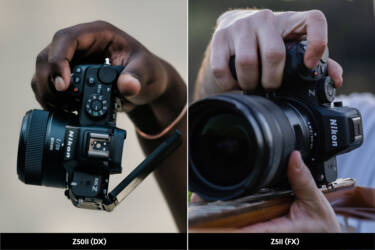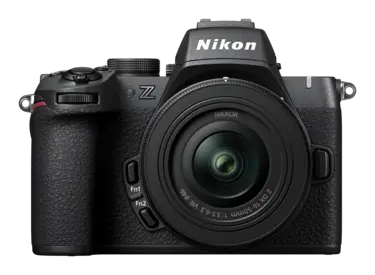Making the move from DX to FX

If you’re thinking of changing from a Nikon DX (crop sensor) camera to an FX (full-frame) model, here are all the facts you need to know
If you already have a Nikon crop sensor DX camera, such as the Z30, Z50II or Zfc, you’re maybe wondering if moving to a full-frame model such as the new Nikon Z5II is for you.
Choosing to move to a full-frame camera can mean some changes to the way you shoot and how you think about things such as focal length of lenses. There are also changes in things including the weight and size of the camera, on-board storage options and low-light performance. So if you’re thinking about moving your sensor up to full frame, here’s where you’ll notice the difference.
What’s in our kitbag?

The red box is an APS-C DX crop (28.4mm) while the yellow equals full frame (35mm)
Focal length
If you’re used to shooting with a DX camera, you’ll need to readjust how you think about the focal length of your lenses. As DX cameras have a crop sensor, the field of view is calculated at 1.5x the focal length of the lens. So using a 35mm lens on a DX camera will actually give you the same field of view as a 52.5mm lens (if such a thing existed, but a 50mm is very close). On full-frame FX cameras, the field of view remains true to the focal length, so if you’ve been used to shooting street photography with a 35mm lens, change up to a 50mm.
Size and weight
DX cameras are often smaller and lighter than FX, which is great for unobtrusive street shooting with a small lens, but they can feel unbalanced with larger lenses. If you’re going to shoot sports or wildlife with heavier, longer lenses, a full-frame camera might feel more comfortable and balanced in your hands.

Notice how aperture affects bokeh. From left to right: f/2.8, f/6.3, f/13, f/22. Z6II + NIKKOR Z 24-70mm f/2.8 S at 70mm focal length
Bokeh
Because of the smaller sensor in DX cameras and the cropped field of view, the depth of field is also affected. This means you might have to use a longer focal length lens and/or a lower aperture to achieve the same creamy, blurry background you would get on a full-frame camera.
Low light performance
With their larger sensor, full frame FX cameras often offer better low-light performance than crop sensor models. This means more flexibility when you’re in difficult shooting conditions or want to create mood in dark spaces. FX cameras also generally have more dynamic range than DX bodies. This is how a camera deals with detail in both very dark and very bright parts of the same image and can be advantageous if you want to take pictures of places with a lot of contrasting light but still hold on to all the smallest details.

Storage
If you’re going to need a lot of storage, for video or long, intense stills shoots, FX cameras have more capability than DX bodies, which come with one storage slot. All Nikon’s current DX cameras have one SD card slot, while full-frame Z mount cameras have two on-board card slots: the ZF has one SD and one micro SD, the Z5II comes with two SD, the Z6III, Z7II and Z8 with one SD and one CFexpress and the Z9 with two CFexpress slots.
Prepare to move
If you’re used to capturing with prime lenses on a DX camera body, where you position yourself will change with a full-frame camera using the same lens. For example, if you’re used to using a 50mm lens on your DX camera, you’ll need to move further back to get the same image using an FX body with the same lens, due to crop factor.
Both Nikon DX and FX cameras take fantastic stills and video footage, and all Nikon Z mount lenses can be used on DX cameras as well as FX (DX specific lenses can be used on FX cameras in crop mode). If you’re thinking that full frame is for you, the Z5II is Nikon’s entry-level FX camera, with anything but ‘entry-level’ performance. For a further look at the Nikon Z5II click here.
Unveil our NIKKOR lenses
Featured products
Discover the Nikon Z5II

For limitless creativity








